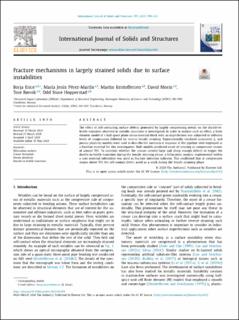| dc.contributor.author | Erice, Borja | |
| dc.contributor.author | Perez-Martin, Maria Jesus | |
| dc.contributor.author | Kristoffersen, Martin | |
| dc.contributor.author | Morin, David | |
| dc.contributor.author | Børvik, Tore | |
| dc.contributor.author | Hopperstad, Odd Sture | |
| dc.date.accessioned | 2021-03-16T09:20:58Z | |
| dc.date.available | 2021-03-16T09:20:58Z | |
| dc.date.created | 2020-05-20T13:11:57Z | |
| dc.date.issued | 2020 | |
| dc.identifier.citation | International Journal of Solids and Structures. 2020, 199 190-202. | en_US |
| dc.identifier.issn | 0020-7683 | |
| dc.identifier.uri | https://hdl.handle.net/11250/2733543 | |
| dc.description.abstract | The effect of self-contacting surface defects generated by largely compressing metals on the ductile-to-brittle transition observed in metallic structures is investigated. In order to analyse such an effect, a finite element model of a half-space plane-strain material block with an imperfection was subjected to different levels of compression followed by reverse tensile straining. Experimentally validated associative J2 and porous plasticity models were used to describe the mechanical response of the pipeline steel employed as a baseline material for this investigation. Both models predicted onset of creasing at compressive strains of around 70%. To ascertain whether the creases created large and sharp enough defects to trigger the ductile-to-brittle transition during the tensile straining phase, a bifurcation analysis implemented within a user material subroutine was used as fracture initiation indicator. This confirmed that at compressive strains above 70% the self-contact defect acted as a crack during the tensile straining phase. | en_US |
| dc.language.iso | eng | en_US |
| dc.publisher | Elsevier | en_US |
| dc.rights | Navngivelse 4.0 Internasjonal | * |
| dc.rights.uri | http://creativecommons.org/licenses/by/4.0/deed.no | * |
| dc.title | Fracture mechanisms in largely strained solids due to surface instabilities | en_US |
| dc.type | Journal article | en_US |
| dc.type | Peer reviewed | en_US |
| dc.description.version | publishedVersion | en_US |
| dc.source.pagenumber | 190-202 | en_US |
| dc.source.volume | 199 | en_US |
| dc.source.journal | International Journal of Solids and Structures | en_US |
| dc.identifier.doi | 10.1016/j.ijsolstr.2020.04.008 | |
| dc.identifier.cristin | 1811911 | |
| dc.relation.project | Norges forskningsråd: 237885 | en_US |
| dc.description.localcode | This is an open access article distributed under the terms of the Creative Commons CC-BY license, which permits unrestricted use, distribution, and reproduction in any medium, provided the original work is properly cited. | en_US |
| cristin.ispublished | true | |
| cristin.fulltext | postprint | |
| cristin.qualitycode | 1 | |

